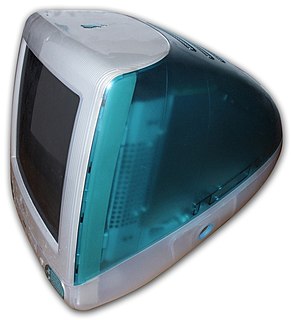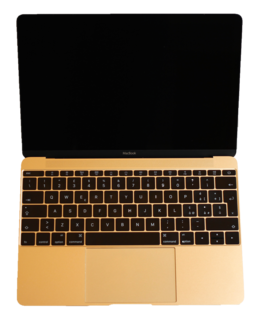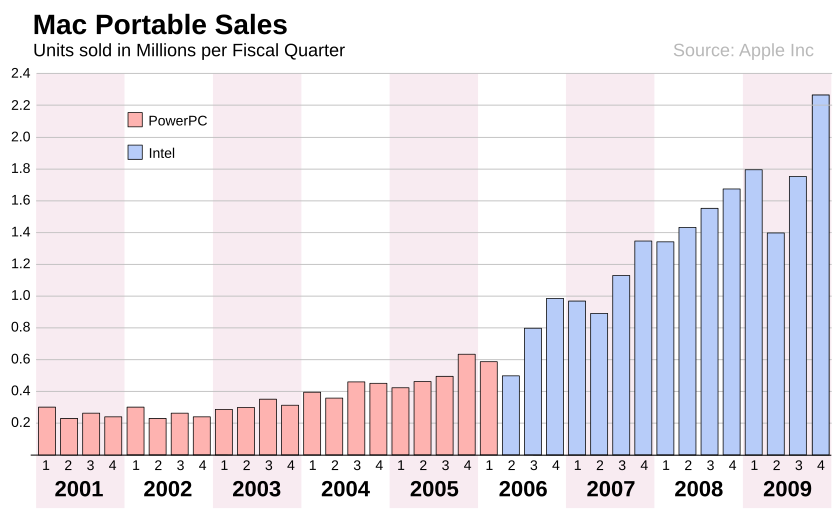
The PowerBook is a family of Macintosh laptop computers designed, manufactured and sold by Apple Computer, Inc. from 1991 to 2006. During its lifetime, the PowerBook went through several major revisions and redesigns, often being the first to incorporate features that would later become standard in competing laptops. The PowerBook line was targeted at the professional market, and received numerous awards, especially in the second half of its life, such as the 2001 Industrial Design Excellence Awards "Gold" status, and Engadget's 2005 "Laptop of the Year". In 1999, the line was supplemented by the home and education-focused iBook family.
Apple Inc. sold a variety of LCD and CRT computer displays in the past. Apple stopped producing its own standalone displays in 2016 and partnered with LG to design displays for Macs, the only displays it sells.

The PowerBook Duo is a line of small subnotebooks manufactured and sold by Apple Computer from 1992 until 1997 as a more compact companion to the PowerBook line. Improving upon the PowerBook 100's portability, the Duo came in seven different models. They were the Duo 210, 230, 250, 270c, 280, 280c, and 2300c, with the 210 and 230 being the earliest, and 2300c being the final incarnation before the entire line was dropped in early 1997.

The Apple Cinema Display is a line of flat-panel computer monitors developed and sold by Apple Inc. between 1999 and 2011. It was initially sold alongside the older line of Studio Displays, but eventually replaced them. Apple offered 20-, 22-, 23-, 24-, 27- and 30-inch sizes, with the last model being a 27-inch size with LED backlighting.

The iMac G3, originally released as the iMac, is a series of Macintosh personal computers designed, manufactured, and sold by Apple Computer, Inc. from 1998 to 2003. Noted for its innovative enclosure via the use of translucent and brightly colored plastics, it was the first consumer-facing Apple product to debut under the recently returned interim CEO Steve Jobs. It was updated over time with new hardware and colors, until being supplanted by the iMac G4 and eMac in 2002.
The MacBook was a line of Macintosh notebook computers designed, manufactured and sold by Apple Inc. from May 2006 to February 2012. A new line of computers by the same name was released in 2015, serving the same purpose as an entry-level laptop. It replaced the iBook series and 12-inch PowerBook series of notebooks as a part of Apple's transition from PowerPC to Intel processors. Positioned as the low end of the MacBook family, below the premium ultra-portable MacBook Air and the powerful MacBook Pro, the MacBook was aimed at the consumer and education markets. It was the best-selling Macintosh ever. For five months in 2008, it was the best-selling laptop of any brand in US retail stores. Collectively, the MacBook brand is the "world's top-selling line of premium laptops."
The Intel-based iMac is a family of Macintosh desktop computers designed, manufactured and sold by Apple Inc. since 2006.

The Apple Mouse began as one of the first commercial mice available to consumers. Over the years Apple has maintained a distinct form and function with its mice that reflects its design philosophies.

iMac is a family of all-in-one Macintosh desktop computers designed and built by Apple Inc. It has been the primary part of Apple's consumer desktop offerings since its debut in August 1998, and has evolved through seven distinct forms.
Thunderbolt is the brand name of a hardware interface developed by Intel that allows the connection of external peripherals to a computer. Thunderbolt 1 and 2 use the same connector as Mini DisplayPort (MDP), whereas Thunderbolt 3 re-uses the Type-C connector from USB. It was initially developed and marketed under the name Light Peak, and first sold as part of a consumer product on 24 February 2011.

A 2-in-1 PC, also known as a 2-in-1 tablet, 2-in-1 laptop, 2-in-1 detachable, laplet, tabtop, laptop tablet, or simply 2-in-1, is a portable computer that has features of both tablets and laptops.

The Apple Thunderbolt Display is a 27-inch flat panel computer monitor sold by Apple Inc. from July 2011 to June 2016. As of 2019, it is the final standalone display designed and sold by Apple. It replaced the former Apple LED Cinema Display. New to the Thunderbolt Display was the switch from Mini DisplayPort and USB to a single Thunderbolt connection for data transfer between computer and display. The increased throughput from switching to Thunderbolt enabled inclusion of a Gigabit Ethernet port and a FireWire 800 port on the display. Older model Macs introduced prior to 2011 with Mini DisplayPort are incompatible with the Thunderbolt Display.

Lenovo Yoga is a range of laptop and tablet computer products from Lenovo, named for their ability to assume multiple form factors due to a hinged screen.

Lightning is a proprietary computer bus and power connector created by Apple Inc. Introduced on September 12, 2012, to replace its predecessor, the 30-pin dock connector, the Lightning connector is used to connect Apple mobile devices like iPhones, iPads, and iPods to host computers, external monitors, cameras, USB battery chargers, and other peripherals. Using 8 pins instead of 30, Lightning is significantly more compact than the 30-pin dock connector and can be inserted with either side facing up. However, unless used with an adapter, it is incompatible with cables and peripherals designed for its predecessor.

The MacBook is a line of Macintosh portable computers introduced in March 2015 by Apple Inc. The MacBook has a similar appearance to the MacBook Air, but is thinner and lighter, and is available in colors called space gray, silver, gold, and rose gold. It offers a high-resolution Retina Display, a Force Touch trackpad, a redesigned keyboard, and only two ports: a headphone jack and a USB 3.1 Type-C port for charging, data transfer and video output.
The Surface Book 2 is a 2-in-1 PC designed and produced by Microsoft, part of the company's Surface line of personal computing. It was unveiled on October 17, 2017 and released on November 16, 2017. It succeeds the Surface Book released in October 2015.






















